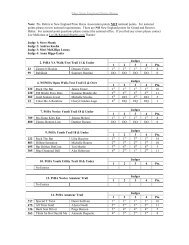2011 Official Rule Book - New England Pinto Horse Association
2011 Official Rule Book - New England Pinto Horse Association
2011 Official Rule Book - New England Pinto Horse Association
Create successful ePaper yourself
Turn your PDF publications into a flip-book with our unique Google optimized e-Paper software.
f. Turns on the forehand.<br />
g. Figure eight at canter on correct lead, demonstrating<br />
flying change of lead.<br />
h. Execute serpentine at a trot and/or canter on correct<br />
lead, demonstrating simple or flying changes of lead.<br />
i. Change leads down center of ring, demonstrating a<br />
simple or flying change of lead.<br />
j. Canter on counter lead. No more than twelve <strong>Pinto</strong>s<br />
may counter canter at one time.<br />
k. Turns on the haunches.<br />
H. Judging<br />
1. Exhibitors to be judged on seat, hands, performance of<br />
mount, appointments of mount and rider and suitability of<br />
mount to rider.<br />
2. Exhibitors should have a workmanlike appearance, seat<br />
and hands light and supple, conveying the impression of<br />
complete control should an emergency arise.<br />
T5. saddle seat Equitation<br />
A. Tack and Attire<br />
1. Attire and equipment shall be the same as in Saddle Seat<br />
Pleasure<br />
2. The saddle must fit the exhibitor.<br />
3. Forward seat or Western saddles are prohibited.<br />
4. Martingales or tie-downs are prohibited.<br />
5. Clothing must be clean, workmanlike and neat.<br />
a. Informal attire consists of conservative colored jackets<br />
with matching jodhpurs and derby or soft hat. Gloves<br />
are optional.<br />
b. Formal attire consists of dark colored riding habit and<br />
accessories or dark tuxedo type jacket and jodhpurs to<br />
match with top hat and gloves. A colored formal jacket<br />
with black jodhpurs and derby or top hat and gloves is<br />
acceptable.<br />
c. Day coats are not acceptable for either informal or<br />
formal attire in equitation.<br />
d. Spurs of the unroweled type that are blunt and round.<br />
e. A slightly flexible whip up to 72” in length, including<br />
lash is optional.<br />
B. Hands/Reins<br />
1. Hands should be held in an easy position, neither<br />
perpendicular nor horizontal to the saddle, and should<br />
show sympathy, adaptability and control.<br />
2. The height the hands are held above the <strong>Pinto</strong>’s withers is<br />
a matter of how and where the <strong>Pinto</strong> carries its head.<br />
3. The method of holding the reins is optional, except that both<br />
hands shall be used and all reins must be picked up at one<br />
time.<br />
4. Bight of rein should be on the off side.<br />
C. Basic Position of Exhibitor<br />
1. To obtain proper position, exhibitor should place him/herself<br />
comfortably in the saddle and find his/her center of gravity<br />
by sitting with a slight bend at the knees, but without use of<br />
irons. While in this position, adjust leather to fit.<br />
2. Irons should be placed under ball of foot (not toe nor<br />
“home”), with even pressure on entire width of sole and<br />
center of iron. Foot position should be natural (neither<br />
extremely in nor out).<br />
D. Position in Motion<br />
1. At the walk, there should be slight motion in the saddle.<br />
2. At the trot, slight elevation in saddle posting; hips under<br />
body, not mechanical up-and-down, nor swinging forward<br />
and backward.<br />
3. At the canter, close seat and going with <strong>Pinto</strong>.<br />
<strong>2011</strong> PtHA <strong>Rule</strong> <strong>Book</strong> 197<br />
ClassEs



